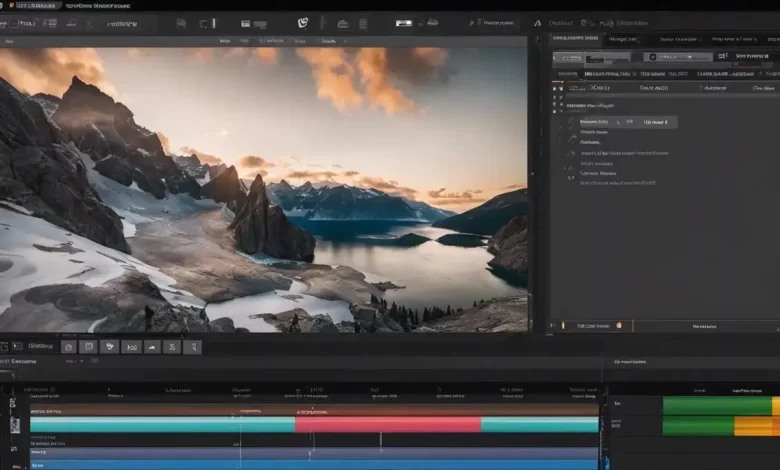
The Best Video Editing Apps & Software
In the world of digital media, refining your creativity and channeling it through impactful video content is paramount. To do so, understanding the power and potential of various video editing software and applications available is vital. This comprehensive guide delves into the aspects that make a video editing tool truly valuable – from an intuitive user interface to multi-cam editing support to the power of audio editing tools. Also, we offer insights into the balance between price and performance across various software solutions. Not leaving behind the surging popularity of mobile video editing, we share insights on how to harness this power efficiently. Lastly, this guide keeps you poised on the cutting edge of video editing technology by exploring the latest trends such as artificial intelligence and machine learning that are reshaping the video editing landscape.
The Best Video Editing Apps & Software
Necessary Features in Video Editing Software
Cracking the code to efficient and professional video editing relies heavily on choosing the right software. The digital market is saturated with countless options, each boasting unique features and luring tech enthusiasts by promising advanced toolsets. However, cutting-edge video editing demands more than just marketing gimmicks- it requires rational analysis of the key facets that truly matter. Let’s delve into the details and explore the essential features to look for in video editing software.
- Non-linear Editing Support
Non-linear editing (NLE) is no longer a luxury, but a necessity. It allows you to access any frame in a digital video clip, irrespective of sequence, providing a more dynamic environment to manipulate and edit the footage. Therefore, your video editing software must include a competent NLE system. - Multicam Editing
Synchronizing footage from multiple cameras in real time often poses a genuine challenge. With multicam editing, that hardship can be substantially mitigated. By integrating footage from different angles into one cohesive narrative, multicam editing enhances the depth and versatility of your project. - High-Quality Transitions and Effects
A video is like a canvas; it needs an artist’s touches to truly come to life. This is where transitions and effects enter the game. High-quality transition options and effects, such as dissolves, wipes, and fades, paint a vivid picture, augmenting the potency and message of your video. - Robust Color and Audio Correction Tools
Color correction and audio engineering are an integral aspect of any video editing process. The software you choose must provide a robust set of tools to tweak the intensity, contrast, saturation, and hue of your visuals, and to refine the clarity, volume, and quality of your audio. - 4K and Virtual Reality (VR) Support
In a world progressively inclined towards high-resolution content and immersive experiences, 4K and VR support are increasingly becoming hot commodities. Besides future-proofing your work, these features take your piece to another dimension of realism and detail. - Direct Sharing to Social Platforms
Social media platforms have morphed into powerful distribution channels. As such, direct sharing tools bridging the gap between your editing software and platforms like YouTube, Instagram, or Facebook should not be overlooked. It fosters efficient content management and a streamlined digital workflow. - Ease of Use
Impressive features are meaningless if the user interface itself is not intuitive or friendly. Although a learning curve is inevitable with any software, the interface should present a straightforward command flow, ensuring a smooth and productive editing process.
Selecting the right video editing software can often seem intimidating in a sea of tech solutions. But armed with this all-important checklist, making an informed decision becomes a walk in the park. Happy editing!
Comparative Analysis of Price vs Performance in Video Editing Software
Unraveling the Price-Performance Value in Top-Tier Video Editing Software
When it comes to video editing software, often there’s a dichotomy that users must navigate; the struggle between budget considerations and performance delivery. Many consider video editing tools an investment, essentially tying their costs to their expected utility. But does price truly align with the quality of performance with these editing tools? Let’s dissect it.
Adobe Premiere Pro and Final Cut Pro are the industry-leading video editing software packages, and they come with a premium price tag. However, they also offer the most comprehensive feature set and the best performance.
For example, Adobe Premiere Pro is known for its robust integration with other Adobe products, such as After Effects and Photoshop. This makes it a powerful tool for creating polished and professional videos. Final Cut Pro is known for its lightning-fast rendering speeds, making it a great choice for users who need to produce videos quickly.
However, there are also some more affordable video editing software options available, such as DaVinci Resolve and HitFilm Express. These options offer a good balance of features and performance, and they can be a great choice for users on a budget.
For example, DaVinci Resolve is a free and open-source video editing software package that offers a wide range of features, including color grading, visual effects, and audio post-production. HitFilm Express is a free video editing software package that offers a variety of effects and transitions, as well as the ability to create 3D animations.
Ultimately, the best video editing software for you will depend on your specific needs and budget. If you need the most comprehensive feature set and the best performance, then Adobe Premiere Pro or Final Cut Pro are the best options. However, if you’re on a budget, there are some great alternatives available, such as DaVinci Resolve and HitFilm Express.
Yet, while some budget-friendly options can match the big players’ performance, not all deliver consistently. Some cheaper or free versions may skimp on usability or lack regular updates, impacting long-term effectiveness. Moreover, expensive products often come bundled with customer support that can be invaluable in a professional setting.
This analysis shows correlations between cost and performance in video editing software are complex. Pricey solutions often lead the pack in terms of advanced features and regular updates. Nonetheless, cost-effective solutions have been shattering the stereotype, proving to be competent contenders, especially for personal use or fledgling projects.
Tips to Utilize the Power of Mobile Video Editing Apps
Moving forth to maximize the utility of mobile video editing apps, keep in mind few pragmatic instructions. Remember, the core of editing is the artful management of pacing, a skill that can be substantially improved with the right use of L and J cuts. These cuts not only help in smoothing the transition between clips but also aid in maintaining a consistent flow, thus creating a professional feel. Experimenting with L & J cuts can enrich visual storytelling to a greater extent.
Moving forth to maximize the utility of mobile video editing apps, keep in mind few pragmatic instructions.
- Use L and J cuts to improve pacing: L and J cuts are editing techniques that can be used to create a more dynamic and engaging video.
- Master the Picture-in-Picture (PiP) tool: PiP is a great way to add interest and variety to your videos. You can use it to show multiple perspectives, or to overlay text or graphics.
- Use classic transitions: While mobile video editing apps may not have a wide range of unique transitions, the classic fade-in and fade-out transitions can be very effective.
- Use basic color correction: Even a simple adjustment to the hue, saturation, and contrast can make a big difference in the look and feel of your video.
- Take advantage of title and text overlays: Title and text overlays can be used to introduce characters, settings, and ideas. They can also be used to add captions or subtitles.
- Use still images: Still images can be used to enhance your video narrative and create visual interest. Try using sequenced slideshows with Ken Burns effects.
- Use the split-screen tool: The split-screen tool can be used to show two different perspectives simultaneously, or to compare two clips. This can be a great way to create a more dynamic and engaging video.
- Mix your audio: Many mobile video editing apps come with basic audio mixing tools. Take the time to balance your audio levels and remove any unnecessary noise.
- Embrace the limitations: Mobile video editing apps have their limitations, but these can also be a source of creativity. By working within the constraints of the app, you can learn to create unique and effective videos.
Overview of the Latest Trends in Video Editing Technology
Looking to the future of video editing tech, several compelling trends are emerging to redefine what’s possible within digital storytelling.
Firstly, AI-based video editing has taken center stage in the industry. As a brilliant blend of Artificial Intelligence and Machine Learning, these next-gen tools are revolutionizing the editing process. The AI algorithms are capable of analyzing the video content, offering frame-by-frame editing suggestions, and even automating many tedious tasks. Industry leaders such as Adobe’s Sensei are paving the way for this groundbreaking technology.
Also on the rise is Cloud-based video editing. Significantly reducing hardware reliance and overcoming geographical constraints, cloud services offer real-time collaboration on projects. This is a game-changer for remote teams, especially in the current work-from-home climate. Tools like WeVideo and Blackbird are frontrunners in making cloud-based editing a reality for many.
Another noteworthy trend is the rise of interactive or immersive video content such as VR, AR, and 360-degree videos. Editing software already had started to cater to these forms with initial support; now, more advanced features are being incorporated. Tools like Adobe Premiere Pro CC are now equipped with specific editing features, including immersive transitions and effects, to specifically handle these types of videos.
On the hardware frontier, GPU-accelerated editing is creating a buzz. Given the computational intensity of video editing, the need for more potent hardware is apparent. Leading software like DaVinci Resolve already utilizes GPU acceleration to enhance workflow and performance. Expect more software to follow on this path.
The trend towards platform-specific video editing is also gaining traction. The popularity of platforms such as TikTok and Instagram has led to an influx of in-app editing features, optimized for the distinctive style of content that thrives on those platforms. Although beginners typically use them, their appeal is broadening.
Finally, the integration of stock footage libraries directly into editing tools is a unique trend worth noting. Streamlining the workflow, this feature helps to speed up the creative process by eliminating the need to separately scour the web for footage. Adobe Premiere Pro’s recent integration with Shutterstock is a prime example.
Taken together, these developments are painting an exciting picture for the future of video editing technology. As the tools and techniques continue to evolve in sophistication, creators are equipped with more and more ways to bring their vision to life seamlessly and efficiently.
Conclusion
This comprehensive guide has navigated you through the wide universe of video editing, equipping you with the knowledge to make an informed choice. Understanding the necessity of crucial features, analyzing software through price-performance lenses, utilizing the power of mobile apps, and staying abreast with the latest technology trends- all these insights prepare you to turn your creative endeavors into visually exhilarating experiences. So whether you’re a budding filmmaker, a content creator, a hobbyist, or a professional editor, you now have the knowledge to harness the power of video editing in creating engaging and high-quality content. Remember, the best tool is the one that enables your vision and allows you to tell your story the way you want. Keep creating, keep exploring!


